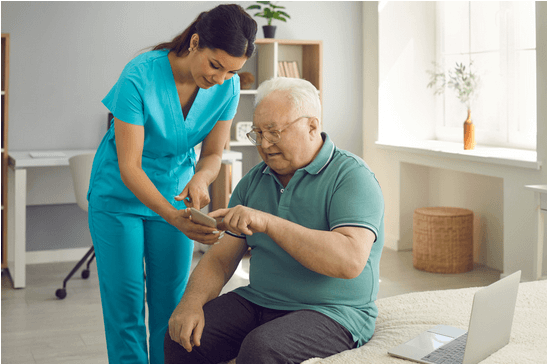As technology and mobility advance, health systems seek new ways to enhance patient care during and after treatment. The use of mobile apps in healthcare has the potential to streamline follow-up processes after procedures like bariatric surgery. Still, questions remain about their ability to reduce in-person visits.
So, should mobile apps be used to limit follow-up visits after surgery? Yes, mobile apps can be used to limit follow-up visits after surgery in the Enhanced Recovery After Surgery (ERAS) program. They provide benefits like reduced costs, time savings, high patient satisfaction, and convenience. However, it is important to consider privacy and security standards and ensure affordable, equitable access to healthcare.
Mobile apps promise to improve certain aspects of postoperative care when used judiciously. Let’s see in-depth why they should be used to limit follow-up visits after surgery.
Why Should Mobile Apps Be Used to Limit Follow-up Visits After Surgery?
Technology won’t slow down any time soon, and with the rise of artificial intelligence, no department will be exempted from technological change. Using mobile apps to limit follow-up visits after surgery is one of them. While there are many concerns around the topic, there are some reasons why it makes sense. They include the following:
Benefits for Patients
The use of mobile applications for postoperative follow-up can provide several important benefits for patients. It reduces the need to visit clinics for routine in-person follow-up visits after surgery. This saves patients time and money spent on transportation costs like fuel, parking fees, or public transit fares.
It also increases the convenience and flexibility of follow-up care. With digital monitoring via an app, patients can receive ongoing assessments of their recovery progress from the comfort and privacy of their homes.
Any signs of complications can be promptly communicated to their surgical team. This also allows for more frequent interactions that improve monitoring compared to typical schedules of weekly or biweekly in-person visits. Mobile apps empower patients to engage in their follow-up care while actively reducing logistical burdens.
Benefits for Healthcare System
Transitioning appropriate post-surgery patients to mobile follow-up can benefit healthcare systems. It lowers costs by reducing unnecessary clinic visits for basic recovery check-ups that see no changes.
Resources like clinic rooms, staff time, and supplies are freed up. This improves the efficiency of follow-up services. Mobile follow-up also expands access to postoperative care. It allows monitoring of patients in remote rural locations with limited specialist access. Telehealth options overcome geographic barriers to receiving continued care.
From a resource perspective, a single practitioner can remotely monitor more patients’ recoveries compared to standard in-person visits that require travel. This optimized utilization of staff expertise benefits healthcare systems seeking to match capacity to service demand.

Evidence of Effectiveness from Research Studies
Several research studies have evaluated the effectiveness of using mobile applications for post-surgery monitoring. The results generally show equivalent or superior outcomes to traditional in-person follow-up visits. Digital follow-up alternatives do not negatively impact clinical outcomes like complication rates.
Studies also report high levels of patient satisfaction with the convenience and experience of telehealth recovery support. Transitioning standard visits to virtual check-ins via an app leads to fewer required clinic follow-up appointments. This is accomplished without a rise in complication frequencies, demonstrating the non-inferiority of digital follow-up pathways.
Related: How Mobile Apps Be Use To Limit Follow Up Visits?
Role in Enhanced Recovery Programs
Mobile apps are well-aligned to support the goals of Enhanced Recovery After Surgery (ERAS) programs that aim to accelerate postoperative recovery. They enable monitoring of patient-reported outcomes to track the recovery process.
Any potential issues or concerns can be rapidly identified from digital updates. This facilitates proactive intervention rather than relying on a reactive approach between scheduled in-office visits.
By maintaining close communication, surgical teams can provide timely guidance to help patients maximize adherence to ERAS protocols. Overall, telehealth recovery support empowers a shift to a more engaged, collaborative model of post-surgery care consistent with ERAS pathways.
What Are the Concerns Around Mobile Apps Being Used?
Many people have raised concerns about using mobile apps for post-op visits. While the benefits are evidently crucial, a few concerns must be considered when deciding to go this route. Some of them include the following:
Clinical appropriateness
Not every surgical procedure and patient is a good candidate for reduced in-person visits replaced by remote monitoring via apps. Operations that are especially complex or associated with higher complication risks may require more direct clinical assessments. Digital check-ins alone are not enough.
Patients with multiple comorbid medical conditions complicating their post-surgery course similarly may need more frequent face-to-face provider evaluations. Clear clinical protocols outlining procedures and patients suitable for telehealth follow-up versus those needing standard office-based care are crucial.
Based on procedure-specific recovery factors, Telehealth should only be utilized when deemed clinically appropriate.
Related: The Effects Of Smart Phone on Patients
Data security and privacy
A key concern for any health technology is maintaining strict data security and adhering to patient privacy regulations. Strong security protocols must be established when collecting and transmitting protected patient medical information via mobile apps.
Data must be encrypted both on devices and during transfer. Systems should align with the U.S. Health Insurance Portability and Accountability Act (HIPAA) standards for safeguarding electronic patient records. Proper user authorization and role-based access controls are also important.
Without robust security, confidentiality breaches could undermine trust in digital health programs and services. Compliance with relevant laws and standards needs oversight.
Resource requirements
Adopting mobile apps for clinical services requires upfront investments and ongoing support costs. Initial expenses involve the development of customized apps with integrated clinical workflows and remote patient monitoring capabilities.
Telehealth platforms must be integrated with medical records systems. Technical support teams are needed to troubleshoot issues with providers and ensure virtual solutions function reliably. Resource needs should not be underestimated for the long-term success of telehealth programs supplementing in-person post-surgery care delivery models.
Medico-Legal Responsibilities
The transition to remote postoperative monitoring via mobile technologies brings new medico-legal considerations. A key concern is the potential for missed identification of postoperative issues or complications during virtual follow-up interactions versus traditional in-person visits. This could hypothetically lead to delayed interventions and poorer outcomes, raising liability concerns should legal disputes occur.
To address this, facilities must establish clear clinical practice guidelines outlining the standard of care expected in remote versus in-person follow-up settings. Proper consent and authorization procedures are also important to ensure patients understand the potential limitations and risks of virtual monitoring platforms versus standard care pathways.
Conclusion
So, should mobile apps be used to limit follow-up visits after surgery? Yes, when used judiciously, mobile apps can reduce costs and travel burdens for patients while improving convenience. They also optimize staff resources and expand access to care. However, not all procedures or patients are suitable, and robust privacy/security protocols must protect patient data. Further research is also needed on scaling implementation balanced with individualized recovery needs.
- How To increasebrown fat: What To Take? - July 23, 2024
- Does Brown Fat Make You Lose Weight? Benefits And Impact - July 21, 2024
- Does Coffee Increase Brown Fat? - July 15, 2024
